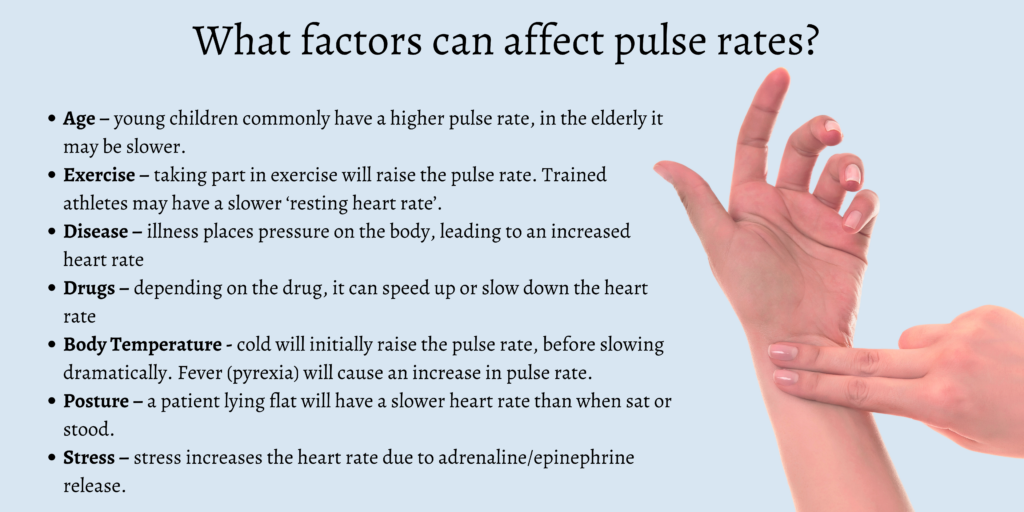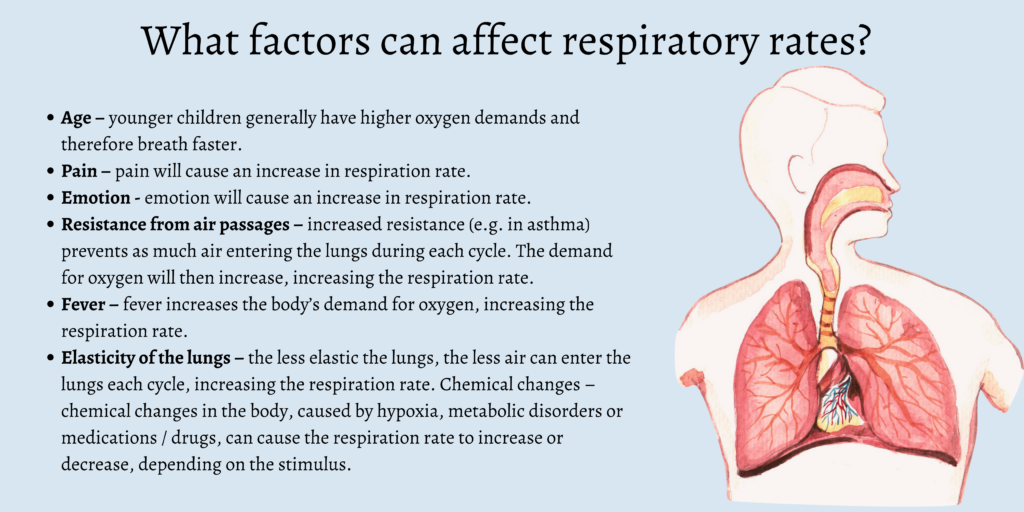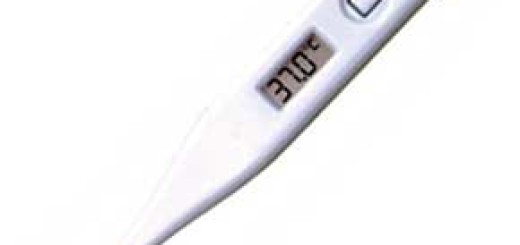What factors can affect pulse and respiratory rates?
Taking an accurate pulse and respiratory rate is a core skill for first aiders.
Pulse and respiration rates are two of the five vital signs used to measure the essential functions of the human body, and these simple markers can tell us a lot about the state of a person’s health.
In a first aid situation, we must act quickly and decisively to detect a medical problem and respond accordingly. So, knowing how to measure a person’s pulse and respiratory rate is crucial, and your findings will help dictate what you do next.
But understanding what affects pulse and respiratory rates is just as important as knowing how to measure these vital signs. So, in this blog post, we’ll examine some of the most critical factors that can increase and decrease these rates.
Pulse Rate
When the heart contracts and pumps blood around the body, the blood vessels (the arteries) expand as the wave of blood passes through.
We can feel this ‘pulse’ where the arteries pass over a solid structure like bone – the wrist is a good example.
The pulse rate (the number of times per minute we can feel the pulse), its strength (whether it’s complete and ‘bounding’ or weak and ‘thready’), and its rhythm (regular or irregular) – can tell us a lot about a casualty.
Age
Young children commonly have a higher pulse rate, and in the elderly, it may be slower. The average resting pulse rate for infants under 12 months old is 80 to 160 bpm. In contrast, older adults have a normal resting range of 60 to 100 bpm.
Exercise
Taking part in the exercise will raise the pulse rate. Trained athletes may have a slower resting heart rate. It’s because the more vigorous exercise a person gets, the more they lower their resting heart rate over time.
Disease
Illness places pressure on the body, leading to an increased heart rate. When the body is under stress due to an illness or infection, the heartbeat often accelerates to pump enough oxygen to our vital organs.
Drugs
Depending on the drug, it can speed up or slow down the heart rate. Certain types of antidepressants, ADHD medications, hormone replacement medications, and medicines to treat respiratory disorders are commonly known to increase a person’s resting heart rate. Caffeine, nicotine, and recreational drugs also speed up the heart rate. On the other hand, cardiovascular drugs such as beta-blockers and calcium channel blockers work in reverse, slowing the heart rate down to a much lower resting level.
Body Temperature
Generally speaking, an increase in body temperature leads to an increase in heart rate. Exposure to the cold will initially raise the pulse rate before slowing it down dramatically. Conversely, fever (pyrexia) will cause an increase in pulse rate.
Posture
A flat patient will have a slower heart rate than sitting or standing. The heart works harder against gravity. At the same time, the person is upright, so it speeds up its contractions to keep up with the increased demand. Stress. Stress increases the heart rate due to adrenaline/epinephrine release. The fight or flight hormone immediately triggers the heart to beat faster as a way of helping the brain and body cope with a challenging situation. It’s one of the reasons why chronically stressed individuals are much more prone to heart disease than those without chronic stress.
Respiratory Rate
Respiration rate refers to the number of breaths taken in any one minute. Normal respiratory rates vary slightly by age and generally increase during exercise. The rate and character of the respirations give us important insights into people’s general health status.
In addition, breathlessness is a very distressing symptom for many people, and it’s crucial to identify problems early and deal with them as quickly as possible.
Several factors can influence a person’s respiration rate, such as:
Age
Younger children generally have higher oxygen demands and therefore breathe faster. Infants have the highest respiration rates of all. However, elderly adults also tend to have an elevated respiration rate compared to their younger counterparts. Respiration rates are also slightly higher in women than they are in men.
Pain
Pain will cause an increase in a person’s respiration rate. Interestingly, some studies have shown that slow-paced breathing works to reduce pain.
Emotion
Feeling strong emotions will cause an increase in respiration rate. For example, anger, anxiety, and fear will trigger your brain to increase the oxygen needed to prepare for a fight or flight response.
Resistance From Air Passages
Increased resistance (e.g., in asthma) reduces the air entering the lungs during each cycle. The oxygen demand will then increase, which in turn, increases the respiration rate.
Fever
Fever raises the body’s demand for oxygen, increasing the respiration rate. Rapid, shallow breathing (known as tachypnea ) also helps the body to release heat.
The Elasticity of The Lungs
The less elastic the lungs, the less air can enter the lungs each cycle, increasing the respiration rate. Elasticity decreases when the lung’s elastin tissues weaken or damage, for example, due to prolonged exposure to environmental conditions such as air pollution or cigarette smoke.
Chemical Changes
Chemical changes in the body, metabolic disorders, and medications/drugs can all cause the respiration rate to increase or decrease, depending on the stimulus. For example, when the amount of carbon dioxide in the blood rises, the brain triggers the lungs to increase respiration to eliminate excess.
What’s a Normal Respiratory Rate in Adults?
The normal respiratory rate for an adult at rest is roughly 12 to 18 breaths per minute. If an adult’s respiration rate at rest is below 12 or more than 25 breaths per minute, it could indicate the presence of an underlying health condition.
What’s a Normal Respiratory Rate in Children?
The normal respiratory rate for a child is based on their age. Toddlers and babies, for instance, take more breaths per minute in comparison to teens and older children. The normal respiratory rate for children of different ages are as follows:
- Birth to six months: 30 to 60
- Six months to 1 year: 30 to 50
- 1 to 3 years: 24 to 40
- 3 to 5 years: 22 to 34
- 5 to 12 years: 16 to 30
- 12 to 18 years: 12 to 20
What Can Cause a Slow Pulse and Respiratory Rate?
Some of the causes of a slow pulse rate are:
- Drugs
- Heart block
- Lyme disease
- Inflammation
- Chagas disease
- Infections
- Electrolyte deficiencies
- Heart tissue damage associated with aging
- Rheumatic fever and rheumatic heart disease
- Sick sinus syndrome
- Chemical imbalances in the blood
- Metabolic problems
- Obstructive sleep apnea
- Complications caused due to heart surgery
The causes of a slow respiratory rate could be:
- Head injuries
- Alcohol
- Hypothyroidism
- Toxins
- Opioids
- Anxiety and stress
- Electrolyte imbalance
What Can Cause a Fast Pulse and Respiratory Rate?
The following are some of the causes of a fast pulse rate:
- Stress
- Certain medicines
- Heart disease, heart attack, cardiomyopathy, or other kinds of heart problems
- Overconsumption of alcohol or caffeine
- Smoking
- High or low blood pressure
- Use of illegal drugs
- Anemia
Here are a couple of causes of a fast respiratory rate:
- Blood clots
- Allergic reactions
- Diabetic ketoacidosis
- Pulmonary embolism
- Blood clots
- Panic or anxiety disorder
- Pleural effusion
- Asthma
- Carbon monoxide poisoning
- Sepsis
- Chronic obstructive pulmonary disease (COPD)
FAQs
What is a normal respiratory rate?
If you’re an adult, a normal respiratory rate is between 12 to 18 breaths per minute.
What is a poor respiratory rate?
A poor respiratory rate is anything below 12 or over 25.
Are 30 breaths a minute normal for an adult?
No, 30 breaths a minute isn’t normal for an adult.
What is a normal pulse rate?
A normal resting heart rate for an adult is between 60 to 100 beats per minute.
What is an unsafe pulse rate?
An unsafe pulse rate is when a person’s heartbeat falls below 60 beats per minute or goes over 120-140 beats per minute.
Conclusion
Pulse and respiratory rates can tell a lot about a person’s health. Knowing the factors affecting these vital signs is crucial to first-aider training. Read our in-depth guide here for more information on measuring a patient’s vital signs in a first-aid situation.






